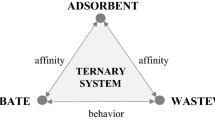Abstract
The interaction of various concentrations of sodium sulfide, dodecylamine (DDA) and oleic acid (OA) on smithsonite were investigated at different pH levels using zeta potential, contact angle, microflotation and diffuse-reflectance FT-IR studies. Flotation results show that the recovery and contact angle are enhanced to 94% and 115°, respectively, with a dodecylamine concentration of 1.6 × 10t−3 M and a pH of 11.5. The optimum sodium sulfide consumption was found to be 2.6 × 10−2 M. Zeta potential measurements showed less negative charge after DDA treatment on the surface of pure crystalline smithsonite. The recovery and contact angle for oleic acid flotation rises to 93% and 105°, respectively, with an oleic acid concentration of 1.1 × 10−3 M and a pH of 10. The zeta potential in the case of using oleic acid showed a more negative charge after oleic acid treatment on the smithsonite surface. The FT-IR spectra studies of smithsonite conditioned with DDA confirmed the adsorption of DDA on the smithsonite surface. The spectra show that the mineral surface is changed partially to a ZnS layer after sodium sulfide treatment. The spectra confirmed the formation of zinc oleate on the smithsonite surface after oleic acid treatment. A comparison of the results using cationic and anionic collectors showed that the different adsorption densities of the reagents in two cases conferred different degrees of hydrophobicity on the smithsonite surface.
Similar content being viewed by others
References
Abramov, A., 1961, “Use of cationic agents for the flotation of oxide lead-zinc minerals,” Chemical abstract, Vol. 55, 26910f.
Billi, M., and Quai, V., 1963, “Development and results obtained in the treatment of zinc oxide ores at AMMI mines,” IMPC, London, Paper 43.
Bustamante, H., and Shergold, M., 1983, “Surface chemistry and flotation of zinc oxide minerals: I-Flotation with dodecylamine,” Trans. Inst Min. Metal, p. 92.
Farmer, V.C., 1974, The Infrared Spectra of Minerals, Mineralogical Society, pp. 239.
Ferraro, J.R., 1982, The Sadtler Infrared Spectra Handbook of Minerals and Clays, Sadtler, 440 pp.
Gadsden, J.A., 1975, Infrared Spectra of Minerals and Related Inorganic Compounds, Butterworth, p. 66.
Gaudin, A.M., 1957, Flotation, McGraw Hill Inc., New York, pp.182–189.
Gong, Wen Qi, Parentich, A., Little, L.H., and Warren, L.J., 1992, “Adsorption of oleate on apatite studied by diffuse reflectance infrared Fourier transform spectroscopy,” Langmuir 8, pp. 118–124.
Healy, T.W., and Moignard, M.S., 1976, “A review of electrokinetic studies of metal sulfides,” Flotation: A.M. Gaudin Memorial Volume, M.C. Fuerstenau, ed., AIME, New York, pp. 334–363.
Hu, Y., Luo, L.,and Qiu, G., 1995, “Solution Chemistry of electrokinetic behaviour of carbonate minerals,” Transactions of NF Soc., Vol. 5, No. 4, pp. 27–30.
Jang, W., Drelich, J., and Miller, J.D., 1995, “Wetting characteristics and stability of Langmuir-Blodgett carboxylate monolayers at the surfaces of Calcite and Fluorite,” Langmuir 11, pp. 3491–3499.
Jones, G.C., and Jackson, B., 1993, Infrared Transmission Spectra of Carbonate Minerals, Chapman & Hall, London, 200 pp.
Malghan, S.G., 1986, “Role of sodium sulfide in the flotation of oxidized copper, lead and zinc ores,” Minerals & Metallurgical Processing, SME, pp. 158–163.
Marabini, A.M., Alesse, V., and Garbassi, F., 1984, “Role of sodium sulphide, xanthate and amine in flotation of lead-zinc oxidized ores,” Inst. of Mining & Metallurgy, pp. 125–136.
Marabini, A.M., and Rinelli, G., 1986, “Flotation of lead-zinc oxide ores,” Advances in Mineral Processing, Proceedings of a Symposium Honoring Nathaniel Arbitor, P. Somasundaran, ed., pp. 269–288.
McGarry, P.E., and Pacic, Z., 1981, “Flotation of Nonsulfide Zinc Materials,” United States patent: 4253614.
Miller, J.D., and Kellar, J.J., 1999, “Internal reflection spectroscopy for FTIR analysis of carboxylate adsorption by semi soluble salt minerals,” Advances in Flotation Technology, Society for Mining, Metallurgy, and Exploration, Inc., Littleton, Colorado, pp. 45–58.
Ozbayoglu, G., Atalay, U., and Senturk, B., 1994, “Flotation of lead and zinc carbonates ore,” Recent Advances in Materials and Mineral Resources, Penang, Malaysia, pp. 504–509.
Pascal, P., 1962, Complexes du zinc, Nouveau traite de chimie minerale, Masson, Paris, pp. 318–321.
Quaresima, S., Sivadasan, K., Marabini A., Barbaro, M., and Somasundaran, P., 1991, “ Behaviour of colloidal suspensions of zinc carbonate in the presence of copolymers designed for selective flocculation,” Journal of Colloid and interface Science, Vol. 144, No. 1, pp. 159–164.
Önal, G., Bulut, G., Gül, A., Kangal, O., Perek, K.T., and Arslan, F., 2005, “Flotation of Aladag oxide lead-zinc ores,” Minerals Engineering, Vol. 18, pp. 279–282.
Ramachandandra, R.S., and Helper, L.G., 1977, “Equilibrium constants and thermodynamics of ionization of aqueous hydrogen sulphide,” Hydrometallurgy, Vol. 2, pp. 293–299.
Rausch, D.O., and Mariacher, B.C., 1970, “Concentration of oxide ores at Tynagh Mining and concentrating of lead & zinc,” AIME World Symposium on Mining & Metallurgy of Lead & Zinc, Vol. 1, Extractive metallurgy of lead and zinc, pp. 721–731.
Rey, M., 1979, “Memoirs of milling and process metallurgy: 1-flotation of oxidised ores,” Institution of Mining and Metallurgy, pp. 245–250.
Rey, M., 1953, “The flotation of oxidized ores of lead, copperand zinc,” Recent Developments in Mineral Dressing Symposium, IMM, London, pp. 541–548.
Rey, M., Sitia, G., Raffinot P., and Formanek, V., 1954, “Flotation of Oxidized zinc ores,” Mining Engineering, pp. 416–420.
Smith, B.C., 1998, Infrared Spectral Interpretation: A Systematic Approach, CRC Press, Washington, DC, 265 pp.
Weiss, N.L., 1985, SME Mineral Processing Handbook, SME, pp. 15–24.
Zhang, Q., Xu, Z., and Finch, J.A., 1995, “Prediction of species distribution at sphalerite/water interface,” Minerals Engineering, Vol. 8, pp. 999–1007.
Author information
Authors and Affiliations
Rights and permissions
About this article
Cite this article
Hosseini, S.H., Forssberg, E. Adsorption studies of smithsonite flotation using dodecylamine and oleic acid. Mining, Metallurgy & Exploration 23, 87–96 (2006). https://doi.org/10.1007/BF03403341
Received:
Revised:
Accepted:
Published:
Issue Date:
DOI: https://doi.org/10.1007/BF03403341




